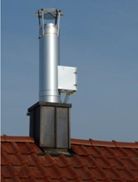Ultra Low dust: small-scale biomass combustion technologies with ultra-low emissions
An ensemble of three innovative technologies covering the whole range of residential biomass heating appliances defines a new State of the art regarding ultra-low emission biomass combusting systems. These technologies are: ultra-low emission pellet and woodchip boilers; new stove technology based on optimised air staging and on automated control system; new electrostatic precipitator system (ESP) for old stoves and boilers.

The challenge
Wood is a source of renewable energy. Yet the stock of domestic wood heating appliances actually in use participates significantly in particulate matter (PM) emissions. More efficient appliances are required in order to improve ambient air quality and make wood burning appliances an economic and ecological alternative to electric heating systems.
The innovation
The EU-Ultralowdust project, co-financed by the FP7 grant funding programme, has developed an approach for ultra-low emission small-scale biomass combustion appliances. Completed in March 2014, the project gathered partners from three European countries and was coordinated by BIOS BIOENERGIESYSTEME GmbH (Austria), a company specialised in energy efficient design from biomass (R&D, planning and optimisation of processes and plants).
Three innovative technologies were developed in the frame of the project.
An ultra-low emission boiler technology (UleWIN): it actually operates at almost zero Carbon monoxide (CO), organic gaseous carbon (OGC) and particulate matters (PM). A new stove technology equipped with an automatic air distribution device: it regulates air inlets through the different stages of wood combustion, thereby injecting the necessary quantity of air at both the right place and the right time. An electrostatic precipitator (ESP) that reduces the emission of PM emitted by biomass stoves and boilers. The ESP can be mounted on existing chimneys as shown in figure below:The ESP is composed of a High Voltage negatively charged electrode: dust particles are charged and driven towards a grounded collecting electrode where they accumulate. A magnetic vibrator operates periodic cleaning of the inner tube, thereby ensuring long-term operation without requiring manual cleaning.
Why did it work?
The ensemble of technologies developed in the frame of the project provides the end-user with devices that are:
ecological (i.e. low emissions during all phases of operation: combustion and filtration),economical (i.e. low consumption of wood and meeting the requirements of energy efficiency in buildings), andcomfortable (i.e. easy to use for producing constant heat and for filtrating dust emissions).Moreover, the EU-ultralowdust project covers the entire innovation cycle from research to market introduction. This means:
Development of innovative technologies at lab scale and demonstration in field,Elimination of weak points to make the system ready for market and development of market introduction strategies and techno-economic analyses,Efficient dissemination towards a group of experts and public at large,Recommendations based on the results regarding new regulations about emission limits.Further deployment
As the technologies developed in the project were demonstrated in field (during two heating seasons in 2011/12 and 2012/13) and that already approximately 20 units have been available on the market (concerning the ESP), the technology readiness level is estimated to be 9 on the TRL scale.
Links:
Project website